|
The aim of this study was to compare the effects of cryopreservation at approximately -196 °C in liquid nitrogen (N) and freezing at approximately -20 °C in a freezer, on the viability and survival of eight different mastitogenic bacteria inoculated in milk. Bacteria were frozen at approximately -20 °C in a freezer and cryopreserved at approximately -196 °C in liquid nitrogen. An effective preservation method was needed for follow-up samples from cows identified in the South African National Milk Recording Scheme (NMRS) with somatic cell counts above 250 000 cells/mL milk. The organisation responsible for sample collection of the NMRS milk samples also provides producers with liquid nitrogen for their semen flasks at the collection sites. This existing mode of storage and transport could therefore be utilised.Ten samples of each organism were thawed and cultured bi-weekly until week 18 for both temperature treatments. An additional sampling was performed at week 30 for samples frozen at approximately -20 °C. Freezing and cryopreservation did not impair subsequent isolation of Streptococcus dysgalactiae, Streptococcus uberis, Enterococcus faecalis, Staphylococcus aureus (STH) (phage type lytic group III) or Sta. aureus (STA) (phage typed, other than lytic group III). Survival was indicated by the isolation of bacteria from samples, and viability by the strength of growth of the bacteria isolated. The survival of Streptococcus agalactiae decreased after week 12 and Escherichia coli after week 16 of freezing, but both organisms survived under cryogenic preservation until week 18. Coagulase-negative staphylococci survived until week 18 for both freezing and cryogenic preservation. Both storage methods could thus contribute to the improvement of a pro-active approach towards udder health management in South African dairy herds.
Detection and identification of pathogens in milk has become a valuable tool for monitoring the udder health of modern dairy cows. Culturing of milk from cases with increased somatic cell counts (above 250 000 cells/mL) can also be used to assist producers in a pro-active approach to herd udder health.Freezing can be lethal to many living systems; whilst preserving some cell structures, it disrupts others and the ability of micro-organisms to withstand freezing might differ (Mazur 1970). Variable results have been reported by different authors who assessed the survival and viability of mastitogenic organisms in milk at temperatures of -20 °C and -80 °C. Whilst some studies (Bashandy & Heider 1979; Luedecke et al. 1971; Murdough, Deitz & Pankey 1996; Pankey et al. 1987; Schukken et al. 1989) showed that freezing at -20 °C and -80 °C had no effect on the recovery of mastitogenic bacteria, others showed significant increases in the recovery of similar organisms (Hubackova & Rysanek 2007; Schukken et al. 1989; Sol et al. 2002; Villanueva, Tyler & Thurmond 1991). Little has been reported about the effect of freezing and storing on Streptococcus dysgalactiae, Streptococcus uberis, Enterococcus faecalis and coagulase-negative staphylococci. Farrat (1980) demonstrated that freezing at -80 °C yielded higher survival rates of bacteria than freezing at -20 °C. Little, however, is known about the overall survival and viability differences of various mastitogenic bacteria when frozen and when cryopreserved. The objective of this study was to compare the two different freezing temperatures (approximately -20 °C and approximately -196 °C) on the survival and viability of eight mastitogenic bacteria commonly isolated from milk samples of South African dairy herds. The evaluated organisms were Streptococcus agalactiae, Str. dysgalactiae, Str. uberis, coagulase-negative staphylococci, E. faecalis, Escherichia coli and two groups of Staphylococcus aureus differentiated by means of phage typing.
Two methods of preservation were investigated and full cream UHT (ultra-high-temperature processing) milk was selected as the diluent to standardise bacterial concentrations. Milk samples where SCC increased to more than 250 000 cells/mL, and not only milk from cows with clinical mastitis, were to be examined. A chest freezer was used in this study to simulate field conditions (Schukken et al. 1989).
Sample preparation
Eight mastitogenic bacteria namely, Sta. aureus (phage type, lytic group III), Sta. aureus (phage type, other than lytic group III), Str. agalactiae, Str. dysgalactiae, Str. uberis, E. faecalis, coagulase-negative staphylococci and E. coli were obtained from field cases of mastitis just prior to commencing this study. These eight bacteria were re-cultured from primary culture plates and incubated for a period of 24 hours to obtain pure cultures. Negative control plates were used in all cases to verify plate sterility.Colonies of Sta. aureus were mixed thoroughly in physiological saline to obtain a 0.5 McFarland standard that is equal to a 1.5 x 108 cfu/mL bacterial suspension. A volume of 5 mL of this bacterial suspension was added to 480 mL of full cream UHT milk and mixed thoroughly by using a sterile magnetic stirrer prior to, and whilst making, aliquots. Aliquots of 1.5 mL each were pipetted into 201 marked Eppendorf tubes [1.5 mL Eppendorf micro test tubes, Merck (Pty) Ltd, Midrand South Africa] of which 100 were meant for cryopreservation and 100 for freezing. The content of the remaining 1 tube was plated out on Columbia Agar and incubated for 24 h at 37 °C ± 1 °C to verify growth. This process was repeated for each organism in this trial. Ten tubes of each of the eight organisms were packed together and sealed in plastic bags (for freezing in a chest freezer) and separate cryogenic canisters (for cryopreservation in liquid nitrogen) to ensure minimum disturbance of the remaining samples on test days, on removal of test samples from the freezer and nitrogen tank, respectively. In order to ensure that sample tubes remained in the cryogenic canisters, cotton wool was packed firmly on top of the samples in each of the cryogenic containers, to act as a stopper. All cryogenic canisters were fully submerged, without any adaptation period, into the liquid phase of a 14 L liquid nitrogen flask filled to 75% capacity for transportation purposes to the organisation, 30 km away. At the organisation, the cryogenic canisters were put into a large liquid nitrogen tank, in excess of 3 m3 and/or a gross weight of 3000 kg (used for storing semen for long periods of time at the organisation), where the samples remained until required for testing. This organisation specialises in storing large quantities of semen over long periods of time. The vacuum insulated tanks were filled twice a week with 30 kg to 50 kg liquid nitrogen as required and kept at a temperature range of -192 °C to -196 °C. Daily monitoring of the liquid level of the tanks is carried out to ensure that all samples remain fully submerged. On each test day, one cryogenic container with all the test samples for that day, was removed by a senior employee of the organisation from the liquid nitrogen tank, and placed directly in a 6 L liquid nitrogen flask filled to 75% capacity for transportation to the milk laboratory. The 10 sealed plastic bags containing the Eppendorf tubes with samples, were stored under identical environmental conditions. The plastic bags containing the samples were placed next to each other in a freezer basket in the centre of the freezer (Frostline, K.I.C. manufacturing, Model Number: OF 355) at approximately -20 °C at the milk laboratory of the Department of Production Animal Studies, Onderstepoort, University of Pretoria. The temperature of this freezer was verified with a digital thermometer and probe (manufactured by Hanna, Model No: HI93530, Serial No: 33948956, Calibrated by Inter Cal Test and Measurement Centre, 907 Richards Drive, Halfway House, Midrand). This freezer was opened not more than twice a week for short periods of time. On each of the test days, 1 of the sealed plastic bags containing samples was removed from the chest freezer.
Experimental procedure
Sample schedule
All the samples were prepared, frozen and cryopreserved on day 0 of the trial. The first testing commenced at week 2 after freezing and continued every 2 weeks thereafter until week 18 for both the samples, frozen and cryopreserved. One additional batch of frozen samples was analysed at week 30 in order to establish extended survival and viability, as this is the method used most commonly in practice.
Thawing of samples
Test day samples from both frozen and cryopreserved batches were thawed at room temperature. The tops of all the Eppendorf tubes of cryopreserved samples were immediately covered with a HDPE (high density poly-ethylene) sheet to prevent the lids of the Eppendorf tubes from popping when taken from the cryogenic canisters, and placed into a micro test tube rack. The samples, of which the lids did pop, were not processed because of possible contamination, which resulted in missing numbers of liquid nitrogen samples. The Eppendorf tubes used were suitable for sample storage between -80 °C and -100 °C, and not -196 °C, hence the popping of lids at thawing.
Identification of mastitogenic bacteria
With each batch of Columbia Agar base plates made, control plates are incubated for 24 h ± 1 h at 37 °C ± 1 °C and evaluated for sterility prior to use. Test milk samples were thawed and plated on Columbia Agar base plates [Oxoid, supplied by Quantum Biotechnologies (Pty) Ltd, Ferndale, South Africa] with 5% defibrinated bovine blood. For each group of bacteria (10 samples) at each test period, one uncultured plate was included as a negative control. Test plates were incubated for 24–48 hours at 37 °C ± 1 °C. Isolated bacteria were identified in accordance with standard laboratory milk culture methodology based on colony morphology, haemolysis, catalase, KOH test and Gram staining. Additional tests included a Strepkit [Latex agglutination test from Oxoid supplied by Quantum Biotechnologies (Pty) Ltd, Ferndale, South Africa], Staphylase Test [Quantum Biotechnologies (Pty) Ltd, Ferndale, South Africa] and the API 20E kit [BioMerieux South Africa (Pty) Ltd, 7 Malibongwe Street, Fontainebleau, Johannesburg, Gauteng 2194, South Africa], (Sandholm et al. 1995; Karzis 2005).
Recording of bacterial growth
Bacterial viability was recorded and based on the strength of bacterial growth. When there were less than 10 colonies, the actual number of colonies was recorded (Figure 1); otherwise the area of growth was used as a semi-quantitative criterion for viability. Scores of 1+, 2+ and 3+ were allocated when growth was evident on ⅓, ⅔, or the complete area of inoculation respectively (Figure 2).
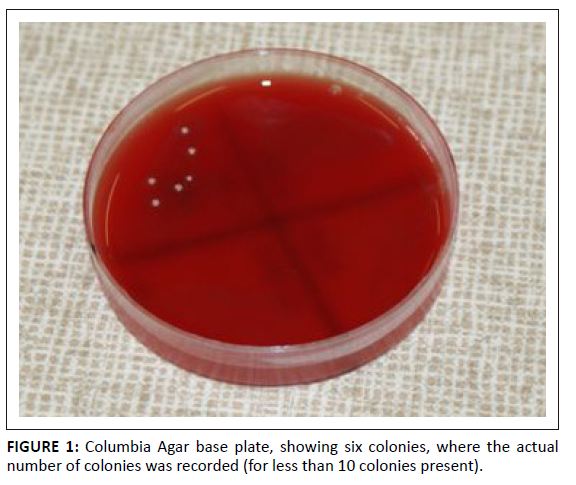 |
FIGURE 1: Columbia Agar base plate, showing six colonies, where the actual
number of colonies was recorded (for less than 10 colonies present).
|
|
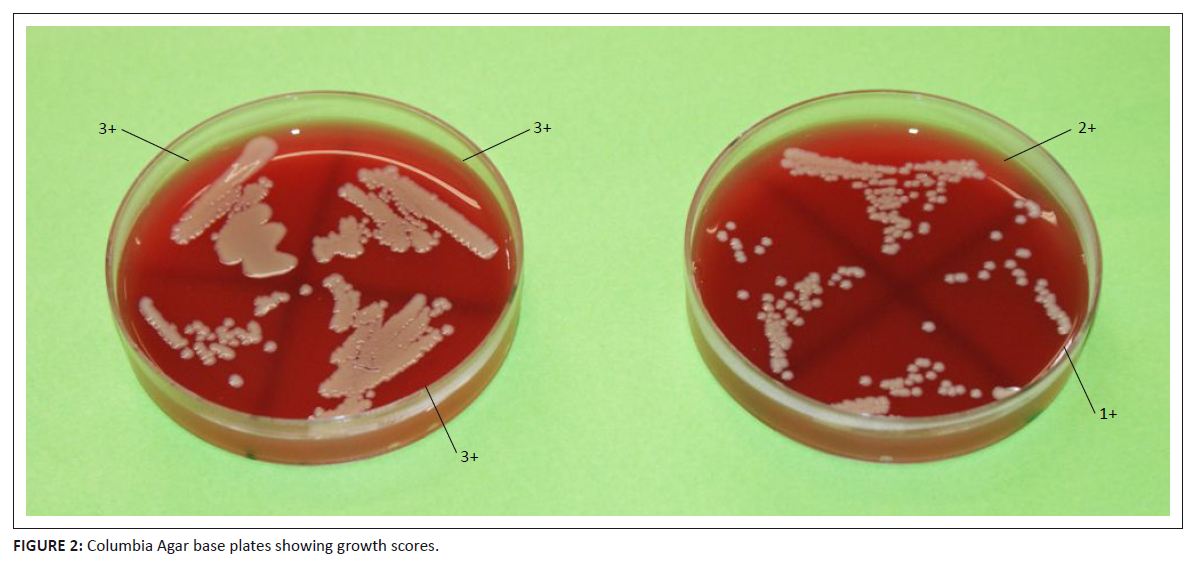 |
FIGURE 2: Columbia Agar base plates showing growth scores.
|
|
Statistical analysis
Statistical analysis was performed by using the Fisher exact test and reported as a two-sided P-value with significance set as P < 0.05.
In some of the 10 batches of cryopreserved samples, less than 10 samples were examined because of sample loss that resulted from the popping of lids of Eppendorf tubes. Streptococcus dysgalactiae, Str. uberis and Sta. aureus (STA and STH) bacteria could be isolated from all samples stored, showing a growth score of 3+ for the full duration of the study at both temperatures.
|
TABLE 1: Comparison between the survival of Streptococcus agalactiae (SAG) and Escherichia coli (ECO) for frozen and cryopreserved samples, for weeks 14¢18.
|
All bacterial samples survived for Str. agalactiae and E. coli for samples frozen and cryopreserved from week 2 to week 12. Differences in survival of the two bacteria between the two preservation methods only occurred from week 14 to week 18 (Table 1). There was a significant difference between the survival of Str. agalactiae samples that were frozen and those that were cryopreserved, for week 14 and week 18 (P = 0.033). There was no significant difference (Table 1) between the survival of the E. coli samples that were frozen and those that were cryopreserved.Although coagulase-negative staphylococci survived in all the samples up to week 18 from both temperature treatments, a decrease in viability was observed after 4 weeks of cryopreservation (Figure 3) and 8 weeks of freezing (Figure 4). In the cryopreserved samples, growth of bacteria scored at 3+ and 2+ were present in all the samples up to week 12 and at week 16. At week 14 coagulase-negative staphylococci were isolated from 83% of samples and at week 18 from 88%. Growths scored at 3+ and 2+ were present only until week 8 in all samples frozen at approximately -20 °C, in 70% of samples at weeks 10, 12 and 18, and in 80% of samples at week 14, and in 50% of samples at week 16 of freezing. At week 30, coagulase-negative staphylococci could only be isolated from 50% of the samples frozen and only with a score of 1+ growth.
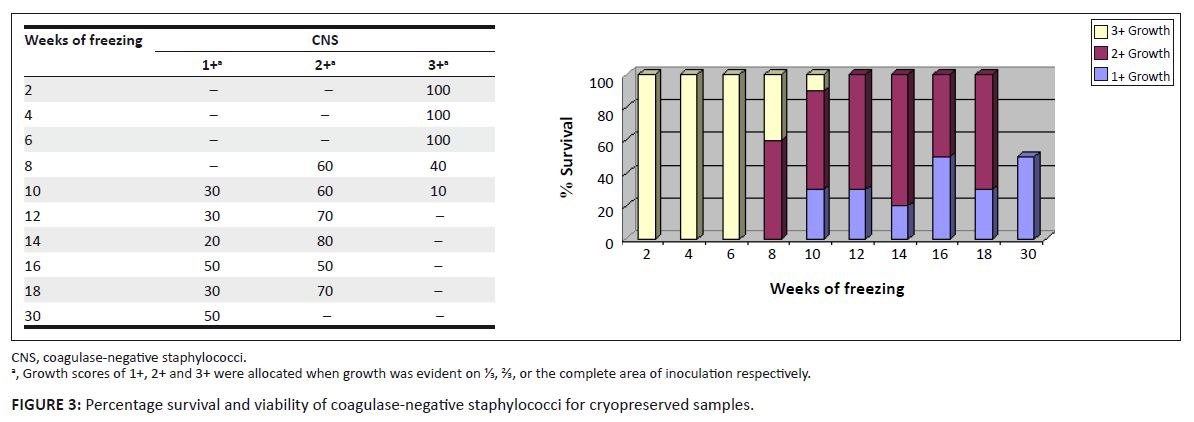 |
FIGURE 3: Percentage survival and viability of coagulase-negative staphylococci for cryopreserved samples.
|
|
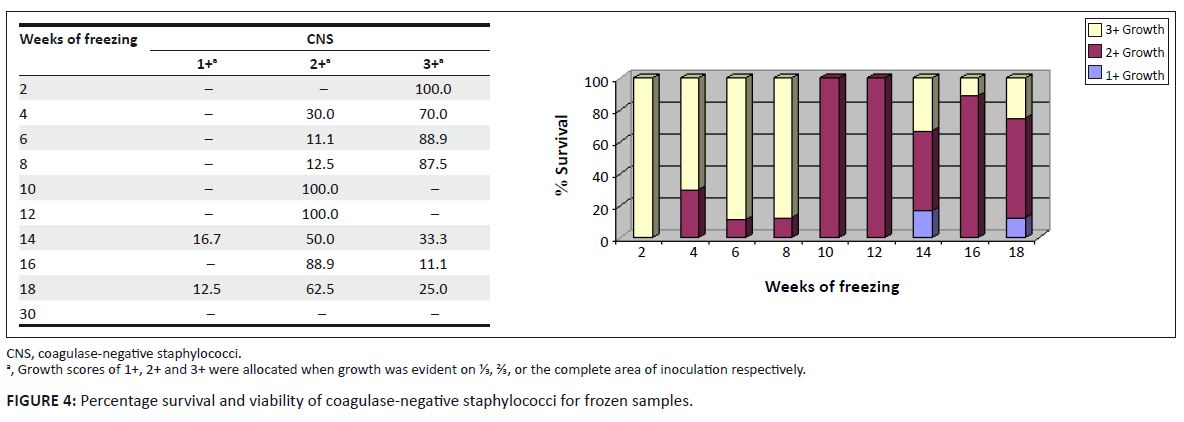 |
FIGURE 4: Percentage survival and viability of coagulase-negative staphylococci for frozen samples.
|
|
Streptococcus agalactiae was isolated from all samples until week 18 and week 12 from cryopreserved and frozen samples, respectively, and from only 50% of samples frozen after week 12.Cryopreserved E. faecalis survived in all the samples showing 3+ growth until week 12 and at week 18, whilst 20% of E. faecalis did not survive at week 8. During week 14 and week 16 viability decreased, showing a growth of 2+ in 20% and 11% of cryopreserved samples, respectively (Figure 5). Enterococcus faecalis survived and remained viable in all frozen samples with a score of 3+ growth until week 30, except for week 12 where viability decreased and 10% of cultures showed a score of 2+ growth.
 |
FIGURE 5: Percentage survival and viability of Enterococcus faecalis for cryopreserved samples.
|
|
Lower survival rates were observed in E. coli at week 14 and week 18 in 10% of cryopreserved samples. Escherichia coli survived in all frozen samples up to week 16, but only from 50% of samples at weeks 18 and 30. At week 12 only 20% of the cultures decreased in viability, showing a score of 2+ growth (Figure 6).
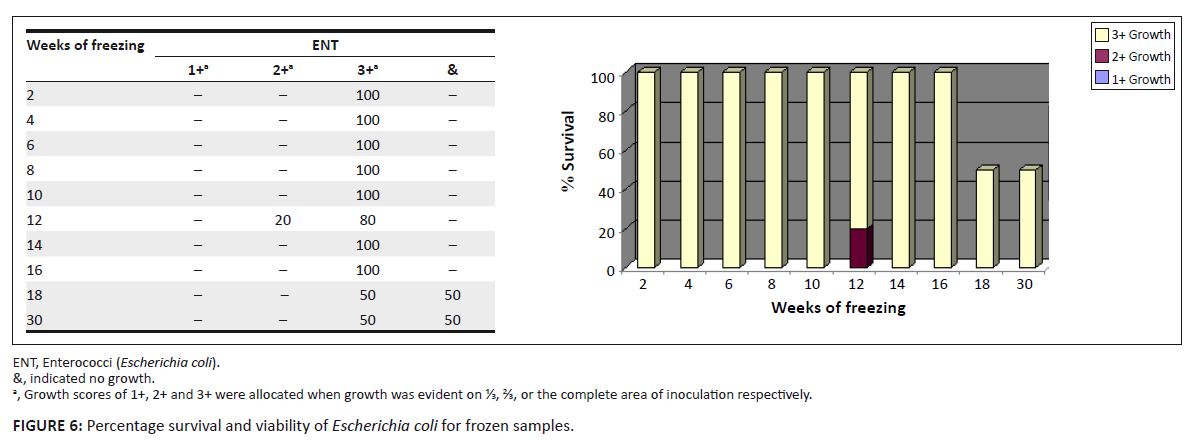 |
FIGURE 6: Percentage survival and viability of Escherichia coli for frozen samples.
|
|
The ability of the organisms to withstand temperatures varied, but in general better survival and viability of bacteria were observed in cryopreserved samples in comparison to frozen samples. The rate at which bacteria are frozen is important, as slow freezing can cause cell wall collapse because of dehydration, or because of the formation of ice crystals which expand and in doing so destroy the cell walls (ed. Harris 1954). The entire cell content might contract and become concentrated causing the acid-base ratio to be altered and the salt concentration to rise to levels that are potentially lethal to cells. A rapid freezing process helps to prevent these destructive events (ed. Harris 1954). Although coagulase-negative staphylococci survived from both temperature treatments until the end of the study, there was a difference in viability. These findings are in agreement with those of Luedecke et al. (1971), which also showed a decrease in colony count during 70 days of storage. This, however, differed from findings of Schukken et al. (1989), and Hubackova and Rysanek (2007), who detected increases in Staphylococcus epidermidis numbers from as soon as 7 days after freezing and which increased with storage periods. Luedecke et al. (1971) and Murdough et al. (1996), however, found no effect on the viability of Sta. epidermidis after freezing. In this study no changes were observed in the survival and viability of Sta. aureus (both STA and STH) after cryopreservation for 18 weeks and
freezing for 30 weeks, which agrees with results recorded by other researchers (Bashandy & Heider 1979; Luedecke et al. 1971; Murdough
et al. 1996; Pankey et al. 1987; Schukken et al. 1989) who reported that freezing at temperatures of -20 °C and -80 °C
had no effect on the recovery of Sta. aureus. Sol et al. (2002) even reported an increase in Sta. aureus numbers during freezing.
There was 100% survival of E. coli up to week 16 for frozen samples, and week 12 for cryopreserved samples. The viability of frozen samples decreased at week 12, however, whilst no decrease in viability was observed for cryopreserved samples. These findings are in agreement with the report of Murdough et al. (1996), but contradict numerous other studies that found significant declines in the isolation of E. coli from as early as 72 hours after freezing (Hubackova & Rysanek 2007; Pankey et al. 1987; Schukken et al. 1989; Sol et al. 2002; Storper, Ziv & Saran 1982). An observation was made during this study that E. coli colonies took more than double the time to react with 5% KOH from weeks 10 and 12 than for frozen and cryopreserved samples, respectively. Results from literature on the survival of Str. agalactiae have been varied. The results obtained in this study for frozen samples are in agreement with
studies of Luedecke et al. (1971); Bashandy and Heider (1979), and Storper et al. (1982), who all observed a significant decrease in survival over
time. Villanueva et al. (1991) on the other hand, found a 2.50-fold increase in colony numbers when stored at -20 °C
for 23 days, whilst Sol et al. (2002) found that Str. agalactiae could be isolated from more samples if incubated at
37 °C after freezing. Murdough et al. (1996) showed no differences in the survival of Str. agalactiae after being frozen for
6 weeks. In cryopreserved samples there was no observed decrease in either the survival or the viability of Str. agalactiae. This study found no difference in the survival and viability of Str. uberis and Str. dysgalactiae between frozen and cryopreserved samples over
time, and only slight differences for E. faecalis. These findings are in agreement with those of Murdough et al. (1996) who detected no significant
changes in the survival of Str. dysgalactiae and Str. uberis numbers. Results of Bashandy and Heider (1979); Storper et al. (1982) and
Pankey et al. (1987), however, found a significant decrease in the survival of non-agalactiae streptococcal isolates that were recovered
from milk samples stored at temperatures of -18 °C to -70 °C. Staphylococcus aureus (STA and STH), Str. dysgalactiae and Str. uberis were frozen and cryopreserved for 18 and 30 weeks respectively, without a reduction in survival and viability. Although coagulase-negative staphylococci survived until week 18 for frozen and cryopreserved samples, viability decreased after week 8 for frozen samples, and week 2 for cryopreserved samples. In the case of E. coli, cryopreservation had a slight advantage of survival for 2 weeks longer compared to samples that were frozen at approximately -20 °C in a freezer. Streptococcus agalactiae had the largest variation in survival between frozen and cryopreserved samples after week 12, namely 100% survival in cryopreserved samples, and only 50% in frozen samples. This study has indicated that milk can be frozen for at least 12 weeks and cryopreserved for up to 18 weeks, for the eight most commonly isolated mastitogenic organisms in South Africa. The process of thawing cryopreserved samples, however, in this study caused sample loss through the use of Eppendorf tubes, which were suitable for storage between -80 °C and -100 °C and not for cryopreservation. The use of suitable containers for cryopreservation will prevent loss of samples during thawing. Both freezing and cryopreservation can contribute to improving pro-active udder health management.
The authors of this paper thank the Cryogenic Facility at Taurus, Irene, South Africa for the use of their facilities in storing milk samples in liquid nitrogen.
Competing interests
The authors declare that they have no financial or personal relationship(s) which may have inappropriately influenced them in writing this paper.
Authors’ contributions
I.M.P. (University of Pretoria) was the project leader. I.M.P. (University of Pretoria), J.C.W. (University of Pretoria) and T.J.v.d.S. (University of Pretoria) were responsible for experimental and project design. N.M.I. (Herd Husbandry Help CC) assisted with the storage of samples in liquid nitrogen (-196 ºC) by making facilities available. S.E. (University of Pretoria) assisted with data capturing. J.K. (University of Pretoria) and I.M.P. (University of Pretoria) were responsible for the literature review, the writing-up of the article, and G.T.F. (University of Pretoria) assisted with data utilisation and statistical analysis.
Bashandy, E.Y. & Heider, L.E., 1979, ‘The Effect of Freezing Milk Samples on the Cultural Results’, Zentralblatt fϋr Veterinärmed Reihe 26, 1–6. Farrat, J., 1980, ‘Freeze-thaw Injuries in Living Cells’, International Journal of Refrigeration 3, 191.
http://dx.doi.org/10.1016/0140-7007(80)90045-6 Harris, R.J.C. (ed.), 1954, Biological applications of freezing and drying, Academic Press Incorporated, New York. Hubackova, M. & Rysanek, D., 2007, ‘Effects of Freezing Milk Samples on the Recovery of Alimentary Pathogens and Indicator Microorganisms’, Acta Veterinaria
Brunensis 76, 301–307. http://dx.doi.org/10.2754/avb200776020301 Karzis, J., 2005, ‘Intramammary antibiotics in dairy goats: Withdrawal periods and tissue tolerance’, MSc thesis, Dept. of Production Animal Studies, University of Pretoria. Luedecke, L.O., Forster, L., Williams, K. & Hillers, J.K., 1971, ‘Effect of Freezing and Storage at -20 °C on Survival of Mastitis Pathogens’, Journal of Dairy
Science 55, 417–418. http://dx.doi.org/10.3168/jds.S0022-0302(72)85509-7 Mazur, P., 1970, ‘Cryobiology: The Freezing of Biological Systems’, Science 168, 939–949.
http://dx.doi.org/10.1126/science.168.3934.939,
PMid:5462399
Murdough, P.A., Deitz, K.E. & Pankey, J.W., 1996, ‘Effects of Freezing on the Viability of Nine Pathogens from Quarters with Subclinical Mastitis’, Journal of Dairy Science 79,
334–336. http://dx.doi.org/10.3168/jds.S0022-0302(96)76368-3 Murray, P.R., Baron, E.J., Jorgensen, J.H., Landry, M.L. & Pfaller, M.A., 2007, Manual of Clinical Microbiology, 9th edn., ASM Press, Washington DC. Pankey, J.W., Wadsworth, J.K., Metha, K.H. & Murdough, P.A., 1987, ‘Effects of Storage on Viability of Mastitis Pathogens’, Journal of Dairy Science 70(1), 132. Schukken, Y.H., Smit, J.A.H., Grommers, F.J., Vandegeer, D. & Brand, A., 1989, ‘Effects of Freezing on Bacteriologic Culturing on Mastitis Milk Samples’, Journal of Dairy Science
72, 1900–1906. http://dx.doi.org/10.3168/jds.S0022-0302(89)79309-7 Sandholm, M., Honkanen-Buzalski, T., Kaartinen, L. & Pyörälä, S., 1995, The Bovine Udder and mastitis, University of Helsinki, Faculty of Veterinary medicine, Helsinki. Sol, J., Sampimon, O.C., Hartmane, E. & Barkema, H.W., 2002, ‘Effects of Preculture Freezing and Incubation on Bacteriologic Isolation from Subclinical Mastitis Samples’, Veterinary
Microbiology 85, 241–249. http://dx.doi.org/10.1016/S0378-1135(01)00507-7 Storper, M., Ziv, G. & Saran, A., 1982, ‘Effect of Storing Milk Samples at -18 °C on the Viability of certain Udder Pathogens’, Refuah Vetterinarith 39, 1–2. Villanueva, M.R., Tyler, J.W. & Thurmond, M.C., 1991, ‘Recovery of Streptococcus agalactiae and Staphylococcus aureus from Fresh and Frozen Bovine Milk’, Journal of the
American Veterinary Medical Association 198(8), 1398–1400.
PMid:2061157
|
